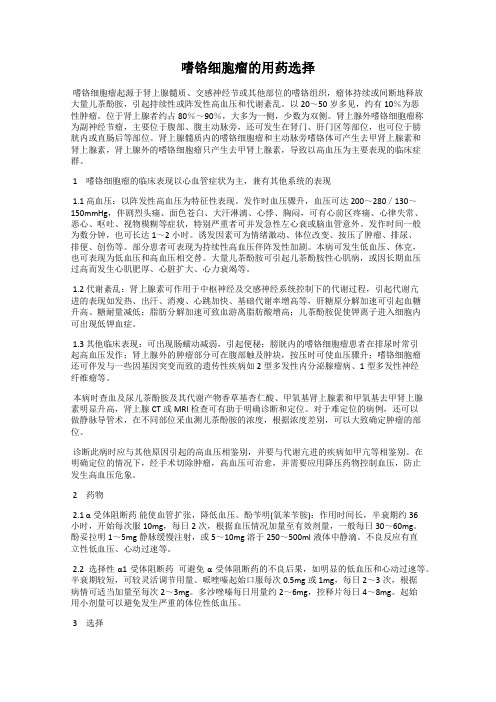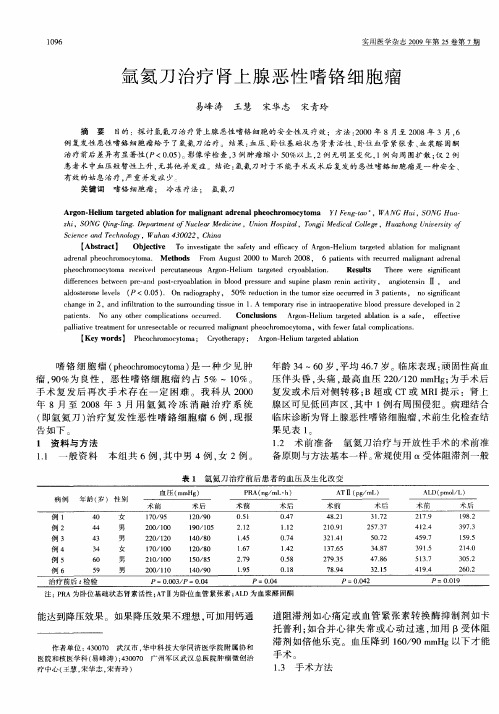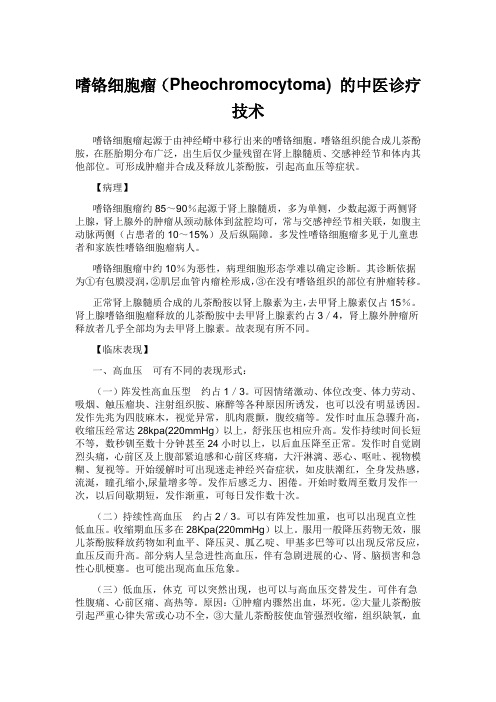恶性嗜铬细胞瘤的治疗
嗜铬细胞瘤诊治进展

嗜铬细胞瘤诊治进展背景介绍嗜铬细胞瘤是一种罕见的神经内分泌肿瘤,通常起源于肾上腺或副交感神经系统的嗜铬细胞。
它们可以分泌儿茶酚胺激素(如肾上腺素和去甲肾上腺素),导致高血压,心动过速和出汗等症状。
因为嗜铬细胞瘤的症状和其他常见疾病非常相似,如高血压和焦虑症,因此它们的诊断和治疗一直是一个挑战。
诊断进展最近的研究表明,许多嗜铬细胞瘤与遗传突变相关联,如多发性内分泌腺瘤和神经纤维瘤病。
因此,家族史是嗜铬细胞瘤疑似患者应该询问的重要问题之一。
现在,诊断嗜铬细胞瘤的关键是通过测量尿液中儿茶酚胺代谢物的含量来检测。
这种检查可以检测到大约90%的嗜铬细胞瘤,但是它有一些缺陷,例如低敏感性和不良特异性。
最近,一些新技术被开发用于诊断嗜铬细胞瘤。
例如,底物类胶体传感器(SBP)和电化学传感器(e-sensor)可以在病人血液或尿液中检测到高灵敏度、高特异性的儿茶酚胺代谢物。
治疗进展嗜铬细胞瘤的治疗目标是完全摘除肿瘤,但该疾病常常处于恶性状态并会迁移到其他部位。
手术切除有助于大多数患者,但对于转移性嗜铬细胞瘤患者,手术可能不是最佳选择。
现在,一些新的治疗方法被开发用于治疗嗜铬细胞瘤。
例如,放射性核素治疗(RNT)和放射性树脂微球治疗(SIRT)可以用于治疗嗜铬细胞瘤的转移性病变。
此外,融合蛋白靶向治疗和免疫疗法也是当前研究的热点。
嗜铬细胞瘤是一种难于诊断和治疗的神经内分泌肿瘤。
最近的研究发展了一些新技术和治疗方法,为嗜铬细胞瘤患者提供了更好的设施。
尽管如此,更多的研究仍然需要开展,以便更好地理解嗜铬细胞瘤的发病机制和治疗方法的有效性和安全性。
嗜铬细胞瘤的用药选择

嗜铬细胞瘤起源于肾上腺髓质、交感神经节或其他部位的嗜铬组织,瘤体持续或间断地释放大量儿茶酚胺,引起持续性或阵发性高血压和代谢紊乱。以20~50岁多见,约有10%为恶性肿瘤。位于肾上腺者约占80%~90%,大多为一侧,少数为双侧。肾上腺外嗜铬细胞瘤称为副神经节瘤,主要位于腹部、腹主动脉旁,还可发生在肾门、肝门区等部位,也可位于膀胱内或直肠后等部位。肾上腺髓质内的嗜铬细胞瘤和主动脉旁嗜铬体可产生去甲肾上腺素和肾上腺素,肾上腺外的嗜铬细胞瘤只产生去甲肾上腺素,导致以高血压为主要表现的临床症群。
1.2代谢紊乱:肾上腺素可作用于中枢神经及交感神经系统控制下的代谢过程,引起代谢亢进的表现如发热、出汗、消瘦、心跳加快、基础代谢率增高等,肝糖原分解加速可引起血糖升高、糖耐量减低;脂肪分解加速可致血游离脂肪酸增高;儿茶酚胺促使钾离子进入细胞内可出现低钾血症。
1.3其他临床表现:可出现肠蠕动减弱,引起便秘;膀胱内的嗜铬细胞瘤患者在排尿时常引起高血压发作;肾上腺外的肿瘤部分可在腹部触及肿块,按压时可使血压骤升;嗜铬细胞瘤还可伴发与一些因基因突变而致的遗传性疾病如2型多发性内分泌腺瘤病、1型多发性神经纤维瘤等。
2药物
2.1 α受体阻断药能使血管扩张,降低血压。酚苄明(氧苯苄胺):作用时间长,半衰期约36小时,开始每次服10mg,每日2次,根据血压情况加量至有效剂量,一般每日30~60mg。酚妥拉明1~5mg静脉缓慢注射,或5~10mg溶于250~500ml液体中静滴。不良反应有直立性低血压、心动过速等。
2.2选择性α1受体阻断药可避免α受体阻断药的不良后果,如明显的低血压和心动过速等。半衰期较短,可较灵活调节用量。哌唑嗪起始口服每次0.5mg或1mg,每日2~3次,根据病情可适当加量至每次2~3mg。多沙唑嗪每日用量约2~6mg,控释片每日4~8mg。起始用小剂量可以避免发生严重的体位性低血压。
外科选恶性静止型肾上腺嗜铬细胞瘤患者围手术期护理

外科选恶性静止型肾上腺嗜铬细胞瘤患者围手术期护理肾上腺嗜铬细胞瘤是指在患者的嗜铬组织当中产生的功能性的肿瘤,其病变区域主要是在肾上腺髓质,其中会有5%的患者转变为恶性瘤。
本文针对外科选恶性静止性肾上腺嗜铬细胞瘤患者的围术期护理问题进行简要分析,研究关于围术期护理对提升手术质量以及降低患者手术死亡率的重要意义,提高和重视围术期的护理水平,具有临床推广意义。
标签:肾上腺嗜铬细胞瘤;围术期护理恶性静止性肾上腺嗜铬细胞的临床表现并无明显特征,更加不会出现高血压或者儿茶酚胺升高的情况。
基于此,进行影像学方面的检查就不能对其进行性质鉴定,对其进行诊治也会出现误差。
目前,恶性静止性肾上腺嗜铬细胞的治疗方法主要是手术,所以加强围术期的手术护理质量对于增加手术成功率具有重要意义。
1 患者资料本文结合我院1例患有做肾上腺肿瘤患者情况对恶性静止性肾上腺嗜铬细胞瘤情况进行简要分析。
该患者为男性,年龄50岁,因左肾上腺肿瘤住院。
患者1个月前健康查体时B超检查发现左肾上腺区一囊性实性占位,后行CT检查示左肾前上方见一截面约14cm×11cm囊实性肿块影,壁厚,边界欠清,中心散在类圆形液性密度区,未见正常肾上腺。
2 护理2.1手术前的护理2.1.1生活方面静止性的嗜铬细胞瘤在特定的环境或者条件下出现应激反应,并会造成患者的血压骤升情况,及相关并发症状。
患者在住院后,要满足患者要求。
另外,对于单人病房患者,应当尽可能保持室内安静,保证患者的情绪稳定等。
2.1.2患者健康情况护理人员应当对患者的健康情况进行充分掌握,并对患者进行健康知识普及,使患者对该病症有充分的了解,做好思想准备,防治出现情绪波动。
2.1.3术前用药护理术前采用A-受体阻滞剂阻断儿茶酚胺的外周血管收缩效应,使微循环血管床扩张,使血容量减少的病理生理变化得到调整或校正[1],配合应用药物扩容,避免肿瘤切除后的难治性低血压性休克的发生。
2.1.4肠道准备术前3d嘱患者进食无渣流质饮食,静脉供给充足营养,安排患者卧床休息,减少体力消耗。
嗜铬细胞瘤的护理诊断

嗜铬细胞瘤的护理诊断及措施定义:嗜铬细胞瘤为起源于神经外胚层嗜铬组织的肿瘤,主要分泌儿茶酚胺,某些患者可因长期高血压致严重的心、脑、肾损害或因突发严重高血压而导致危象,危及生命,但如能及时、早期获得诊断和治疗,是一种可治愈的继发性高血压病。
本病的临床表现个体差异甚大,突然发生恶性高血压、心衰或脑出血等。
治疗原则:手术切除肿瘤是唯一有效的治疗方法。
由于麻醉和手术中血压容易波动,肿瘤血运丰富,肿瘤临近大血管容易引起大量出血,术前应做充分准备。
术前护理诊断:1 潜在并发症:高血压危象护理措施:1卧床休息,吸氧,抬高床头以减轻脑水肿,加用床栏以防病人因躁动而坠床;2按医嘱给予快速降压药如酚妥拉明等;3持续心电监测、血压监测,每15分钟记录1次测量结果;4因情绪激动、焦虑不安可加剧血压的升高,应专人护理,及时安慰病人;5告知患者情绪变化,过度疲劳,腹压增高,刺激挤压瘤体,体位改变,持重物,咳嗽,饥饿,排尿,降压药物服用不当,都是高血压危象发生的诱因,应尽量避免。
2 有跌倒的危险: 与高血压引起头痛头晕、视物模糊有关护理措施:1病床周围无障碍物,加床挡;2加强宣教和病房巡视,防止病人跌伤和坠床;3病人留有陪护,出现异常及时报告医护人员;4减少外出,避免引起血压升高的诱发因素。
术后护理诊断:1体液不足:与肿瘤切除后血浆儿茶酚胺相对不足、血管容积增大有关1术后给予心电监护,严密监测患者意识、血压、脉搏、心率的变化及外周循环情况;2建立2条静脉通道,大量快速补液;3严格记录出入量,观察尿量,若尿量少应注意循环血容量是否充足;4遵医嘱做好液体管理,做好扩容等处理,严防药液外渗;5维持水、电解质、酸碱平衡,定时抽血监测血指标。
2潜在并发症:肾上腺危象1严密观察患者神志变化,有无血压下降、恶心、呕吐、肌无力、大汗和心慌等症状;2保持呼吸道通畅,吸氧;3若发生肾上腺危象,遵医嘱应立即静脉补充肾上腺皮质激素;4遵医嘱纠正水、电解质失衡及低血糖等情况;5做好患者心理护理,保持环境安静,安慰患者以缓解患者的紧张情绪;3 疼痛:与手术所致创伤有关1评估和了解疼痛的程度;2观察病人疼痛的时间、部位、性质和规律;3鼓励病人表达疼痛的感受,简单解释疼痛的规律;4遵医嘱给予镇静、止痛药;5术后可予以留置镇痛泵;6尽可能满足病人对舒适的需求。
嗜铬细胞瘤的病因治疗与预防

嗜铬细胞瘤的病因治疗与预防嗜铬细胞瘤是由嗜铬细胞形成的肿瘤。
肾上腺外的嗜铬细胞瘤可发生在从颈动脉到盆腔的任何部位。
可导致血压异常(常表现为高血压)和代谢紊乱综合征。
有些患者可能会因长期高血压而导致严重的心脏、大脑和肾脏损伤或严重的突然高血压而危及生命。
然而,如果能及时、早期地诊断和治疗,这也是一种可治愈的继发性高血压疾病。
嗜铬细胞瘤在高血压患者中的发病率为0.05%~0.2%发病高峰为20~50岁。
嗜铬细胞瘤占肾上腺的80%%~90%,多为一侧性;肾上腺外肿瘤主要位于腹膜外和腹主动脉旁。
多良性,恶性占10%%..像大多数肿瘤一样,散发性嗜铬细胞瘤的病因尚不清楚。
家族性嗜铬细胞瘤与遗传有关。
本病以20~大多数40岁的中青年患者几乎等于男性和女性。
其主要症状是高血压和基础代谢的变化:高血压可以是阵发性的、持续的或持续的高血压阵发性的。
持续的人通常有头晕、头痛、胸闷、胸痛、心跳心悸、视力模糊、精神紧张、焦虑、怕热等。
阵发性突然严重头痛、心悸、胸闷、苍白、出汗、呼吸急促,患者感到濒死。
此时,如果血压测量可达40.OkPa(200~300㎜Hg),大约半小时后,它可能会自行缓解。
恢复后,就像普通人一样。
在未来,一些刺激会再次发作。
逐渐发作更频繁,间隔缩短,情况也越来越严重。
发作刺激可能不是很强烈,有漱口刷牙或梦发作醒来,出汗,有濒死感。
还有巨大的肿瘤、高血压和无发作症状,或无肿块、无发作,死于其他疾病的手术。
因此,有这种症状的患者应尽快进行检查、诊断和治疗。
嗜铬细胞瘤的一般测试和检查如下:实验室检查:1.测定血尿茶酚胺及其代谢物。
2.药理学试验:分为刺激和抑制试验。
其它辅助检查:1.肾上腺CT首选扫描CT检查时,由于姿势变化或静脉造影剂注射可诱发高血压,应首先使用α-肾上腺素能受体阻断剂控制高血压,并在扫描过程中随时准备酚妥拉明。
2.磁共振显像(MRI)肿瘤与周围组织的解剖关系和结构特征具有较高的诊断价值。
嗜铬细胞瘤怎样治疗?

嗜铬细胞瘤怎样治疗?*导读:本文向您详细介绍嗜铬细胞瘤的治疗方法,治疗嗜铬细胞瘤常用的西医疗法和中医疗法。
嗜铬细胞瘤应该吃什么药。
*嗜铬细胞瘤怎么治疗?*一、西医*1、治疗嗜铬细胞瘤一旦确诊并定位,应及时切除肿瘤,否则有肿瘤突然分泌大量CA、引起高血压危象的潜在危险。
在早期,诊断多依靠临床特点及腹膜后注气造影等不够准确的技术,手术也多以剖腹探查为主,因而诊断错误及手术失败者居多。
近年来,随着生化试验及显像技术的发展,PHEO的定性和定位诊断技术大为提高,术前处理加强摘除PHEO的手术成功率得以提高。
术前应采用α受体阻滞药使血压下降,减轻心脏负荷,并使原来缩减的血管容量扩大,以保证手术的成功。
1.药物治疗(1)PHEO的定性及定位的诊断一旦明确,应立即用药物控制,以防出现高血压急症。
主要用药为长效α受体阻滞药,包括酚苄明(phenoxybenzamine)10~20mg,2次/d;哌唑嗪(prazosin)1~2mg,2次/d。
(2)合并高血压急症时可静脉给以酚妥拉明(phentolamine)。
如疗效不好可静脉输注硝普钠。
(3)如合并窦性心动过速和(或)室上性心动过速心绞痛,可口服选择性β1受体阻滞药,如美托洛尔(bataloc)和阿替洛尔(atendol)等,但在PHEO患者应用该药时,必须与α受体阻滞药合用,否则单独应用β受体阻滞药可能由于抑制了E的血管扩张作用而使血压明显升高,如用普萘洛尔(propranolol)等非选择性β受体阻滞药则升高血压的不良反应更为明显。
(4)如合并室性心动过速静脉输注利多卡因(lidocaine)。
(5)拉贝洛尔(labetalol)为一种α和β受体阻滞药,因其以β受体阻滞药为主,故也可引起血压升高,PHEO时是否应用尚有争论。
2.术前准备和药物治疗(1)α-肾上腺素能受体阻断剂:①酚妥拉明(phentolamine,Regitine):用于高血压的鉴别诊断(Regitine试验),治疗高血压危险发作或手术中控制血压,而不适于长期治疗。
嗜铬细胞瘤

嗜铬细胞瘤治疗
手术治疗 1、术前准备 (1)a肾上腺受体阻滞剂:至少2周,小剂量 开始,逐渐递加,手术前1天止。 (2) ß肾上腺受体阻滞剂:不能单独使用, 只能在使用a-肾上腺受体阻滞剂后使用。 (3)适当补充血容量。
嗜铬细胞瘤治疗
2、手术条件 血压控制到正常或大致正常(120/80±) 阵发性高血压停止 高代谢症状改善 体重增加、出汗减少 血容量恢复(红细胞压积<45%) 酚妥拉明滴注血压不再下降
病例二 尸检记录:后腹膜主 动脉旁可见一直经为 7.5cm的肿块,重约 150g,包膜完整,切 面实性质软,可见小 灶出血。 病理诊断:腹膜后副 神经节瘤伴囊性变。
嗜铬细胞瘤
定义:起源于肾上腺髓质、交感神经节 或其他部位的嗜铬组织,持续或间断地 释放大量儿茶酚胺,引起持续性或阵发 性高血压、交感神经兴奋和代谢紊乱; 但为可治愈性继发性高血压。
性较高,对于肾上腺肿瘤的种类较为困难。
MRI:无放射线,可用于妊娠者,有助于鉴别
嗜铬细胞瘤和肾上腺皮质肿瘤。
B超:无创,方便,初筛,直径>1cm的肾上腺
肿瘤定位,鉴别肿瘤质地。
131I间碘苄胍扫描:显示分泌CA的肿瘤、转移
灶、复发灶、肾上腺外肿瘤。
嗜铬细胞瘤CT
嗜铬细胞瘤MRI
嗜铬细胞瘤诊断
恶性嗜铬细胞瘤诊断:
病例一
入院诊断:心肌炎(考虑病毒性心肌炎可能性大) 治疗:吸氧,抗感染,硝普钠减轻心脏负荷(急 诊有过高血压),护肝,病情稍有好转。 体征:血压100-110/60-70mmHg,心率100-120次/ 分,出汗多(1天换几套衣服)。 检查结果:BR:WBC:14.4*10^9/L,N80.7%巨 细胞病毒:弱阳性。肝酶及心肌酶仍高。 治疗:停用硝普钠(血压稳定后),减慢心率, 护肝,补气强心,加强抗感染。 病情发展:停用硝普钠约8小时后出现血压突然升 高(220-230/130-140mmHg)。患者血压波动范 围大,伴有心悸、乏力,且大量出汗无好转。
嗜铬细胞瘤的诊治

嗜铬细胞瘤:起源于肾上腺髓质产生儿茶酚胺的嗜铬细胞肿 瘤
副神经节瘤:肾上腺外沿交感及副交感神经节分布的嗜铬组 织肿瘤
肾上腺髓质增生:临床表现与嗜铬细胞瘤相似,确诊依靠病 理学检查
高儿茶酚胺血症
副神经节瘤 ( Paragangliomas PGL)
腹主动脉旁(约10%~15%)、肾门、肾上极、肝 门区、肝-下腔静脉之间、胰头部、髂窝或附 近、血管旁(直肠后、卵巢、膀胱内)
MRI
MIBG
诊断PCC的敏感性/特异性分别为 85-88%和 70100%
131I-MIBG具有治疗恶性PPGL的作用 转移性、复发性PPGL、位于颅底和颈部、胸腔、
膀胱PGL,与SDHx基因相关PPGL检出敏感性较低 拟交感神经药、阻断CA转运药物如可卡因和三环
类抗抑郁药、钙同等阻滞剂、α及β肾上腺素能 受体阻滞剂可减少123I-MIBG浓聚,需停药2周
似),若无阳性发现,继以颈部和胸部扫描 儿童也可采用腹部超声 在大多数病例的定位诊断过程中联合使用CT和MR已经足够 MIBG: If CT/MRI negative
Large adrenal tumor paraganglioma PET SRS
良恶性鉴别困难:病理
根据病理切片上的组织形态来判定很困难 瘤细胞的形态异常不能作为良恶性的诊断依据 镜下呈恶性改变,临床却表现为良性 有的瘤细胞呈良性形态,但在术后1~15年内复发 在良、恶性的肿瘤细胞中都可看到重的嗜铬性颗粒、
症状不典型且多变:提高警惕!
传统观念认为:超过一半的患者有高血压发作或危象 实际上:大多数嗜铬细胞瘤是临床上没有料到的(特别是非
内分泌科医师),甚至在与肿瘤相关的致命后果发生时 美国Mayo Clinic尸检:证实的PCC患者中,生前从未被怀疑
氩氦刀治疗肾上腺恶性嗜铬细胞瘤

【 yw rs P ecrm ctm ; Cyteay A gnH l m t gt bai Ke od 】 h oho oyo a ro rp ; ro— eu re da l o h i a e tn
嗜 铬 细 胞 瘤 ( h oho oyo ) 一 种 少 见 肿 p e crm ct ma 是 瘤 ,0 9 %为 良性 ,恶 性 嗜 铬 细 胞 瘤 约 占 5 ~ 1 %。 % 0 手 术 复 发 后 再 次 手 术 存 在 一 定 困 难 。 我 科 从 20 00 年 8月 至 2 0 0 8年 3月 用 氩 氦 冷 冻 消 融 治 疗 系 统 ( 即氩 氦 刀 ) 疗 复 发 性 恶 性 嗜 铬 细 胞 瘤 6例 , 报 治 现
c a g n 2,a d i flr t ot e s r u di is e i A e p r r ie i n ro r ie b o d p e s r e e o d i h n e i n n tai t h uro n ngts u n 1. tm o ay rs n i ta peat l o r s u e d v lpe n 2 i on v
S inc nd T hn lg ce ea ec o o y,W u a 00 2,Chi h n 43 2 na
【 bta t A src】
0bet e T netaetesft ad e cc fA gnH l m t gt b t nfrm l nn jc v oi sgt h ae n f ayo r — ei re d al i o a ga t i v i y i o u a e ao i
p litv r amen ru e e tbl rr c re lg an he c r mo y o a l ie te t a tf nr s ca e o e u d ma in tp o b o c t ma,wi e tf tlc m p ia in . o t f we aa o lc to s h
2024肾上腺皮质癌和恶性嗜铬细胞瘤诊断、治疗和随访的临床实践指南(完整版)

最新:肾上腺皮质癌和恶性嗜铬细胞瘤:诊断、治疗和随访的临床实践指南要点解读(附图表)随着人们生活水平的提高及影像技术的快速发展,肾上腺意外瘤的检出率越来越高。
大多数的肾上腺意外瘤属于良性肿瘤,但仍有<2%的肾上腺意外瘤为恶性病变,且自2017年开始,世界卫生组织(WHO)提出了所有嗜铬细胞瘤和副神经节瘤(phaeochromocytomas and paragangliomas,PPGL)均具有恶性潜力的可能[1]。
故了解肾上腺恶性肿瘤的诊断、治疗及随访对临床工作十分重要。
为提高对此类患者的诊治水平,欧洲16个不同机构、国家的多学科专家小组于2020年首次制定了《肾上腺皮质癌和恶性嗜铬细胞瘤:诊断、治疗和随访的临床实践指南》[2](以下简称《指南》),该《指南》是由欧洲肿瘤内科学会和欧洲罕见成人实体癌症参考网络合作编制,文中提供了证据水平和推荐级别,按照循证医学证据水平,为肾上腺皮质癌(adrenal cortical carcinoma ACC)和恶性嗜铬细胞瘤的诊断、分类、治疗和随访提供了详细的指导意见。
01 流行病学肾上腺癌分为两种,一种是起源于肾上腺皮质的ACC,另一种为来自肾上腺髓质的恶性嗜铬细胞瘤[3]。
嗜铬细胞瘤是一种产生儿茶酚胺的神经内分泌肿瘤,起源于肾上腺髓质或肾上腺外副神经节的嗜铬细胞,后者常称为副神经节瘤,与嗜铬细胞瘤合称PPGL。
据估计,ACC的发病率为每年(0.5~2.0)/百万,其发病高峰出现在儿童和40~50岁人群。
PPGL 的发病率每年在(2~8)/百万,且与年龄呈正相关[4]。
02 诊断与风险评估鉴于此类疾病的发病率较低,且治疗及随访涉及多个学科,故强调对疑似ACC或PPGL患者均应进行多专家小组会诊讨论,诊断主要基于以下几点。
2.1 激素检查激素检查有助于评估肾上腺肿块的良恶性、判断有无危重症风险。
对于所有怀疑为ACC或嗜铬细胞瘤的肾上腺肿瘤患者均应检查肾上腺皮质和髓质激素(表1)。
嗜铬细胞瘤最佳的治疗方法是什么

嗜铬细胞瘤最佳的治疗方法是什么
一、概述
嗜铬细胞瘤不算是一种特别大众化的疾病,很多人甚至没有听过这个疾病,其实这种病主要是由于嗜铬细胞所引起的,对于患者的主要伤害就是持续性的高血压所导致的对心脏、肾脏的伤害,情况严重的患者甚至会导致死亡。
但是嗜铬细胞瘤的患者一般经过正确的诊断、及时的治疗,情况都会大大改善。
所以患者可以不用有那么大的心理压力,下面介绍一些嗜铬细胞瘤的最佳治疗方法。
二、步骤/方法:
1、首先最重要的一点是,如果患者一旦确定了病情,就要及时
切除肿瘤。
不然如果肿瘤突然分泌大量的物体外,可能会引起危险。
现在医学技术飞速发展,一般的诊断什么的都是比较可靠地。
2、如果PHEO的诊断一旦明确了,就应该在医生的同意下,用药物控制,否则可能会出现高血压的急性症状,如果病人一旦承受不住,很容易会因为高血压的症状伤害到心脏、肾脏等器官。
3、一般手术后患者的血压都会很快下降,但是有一部分的患者
可能还存在持续性高血压的症状,这个时候可能是肿瘤没有切除干净,一定要用药物控制,手术后也要及时观测身体的情况,以免有其他变化。
三、注意事项:
对于嗜铬细胞瘤这样的恶性肿瘤疾病来说,最好的就是切除病变
的部位,但是手术后不代表就没事了,患者要及时去医院复检,因为嗜铬细胞瘤属于继发性的疾病,有复发的可能性。
嗜铬细胞瘤

嗜铬细胞瘤嗜铬细胞瘤起源于肾上腺髓质、交感神经节或其他部分的嗜铬组织,这种肿瘤持续或间断地释放大量儿茶酚胺,引起持续性或阵发性高血压和多器官功能异常及代谢紊乱。
2临床评估临床表现高血压:可伴有头痛、大量出汗、心悸。
常规降压药治疗无效。
阵发性或持续习惯高血压、体位性低血压、高/低血压交替性发作,部分患者可出现高血压危象。
高血压危象:伴恶性高血压、高血压性脑病,甚至主动脉破裂和心梗。
约一半的患者出现阵发性发作:骤然起病,血压极高,持续时间不一(从几分钟到数小时不等),伴有头痛、出汗、心悸三联征,恐惧、烦躁、胸痛或腹痛、恶心、呕吐,面色潮红或苍白,甚至惊厥。
体位变换、压迫腹部、活动情绪激动、排便等可能诱发高血压发作。
低血压:多数持续性高血压患者常伴有体位性低血压,少数患者有低血压甚至休克,或高血压与低血压交替出现。
心脏异常:可出现心律失常,心绞痛,心梗,心衰。
心电图可出现非特异性ST-T改变。
其他临床表现:腹部肿块:少数病人在腹部可触及肿块。
消化系统症状:便秘、腹胀、腹痛,甚至结肠扩张,或胃肠壁增殖性及闭塞性动脉内膜炎导致急腹症。
泌尿系统异常:病程久,病情重者可发生肾功能减退。
膀胱嗜铬细胞瘤病人排尿时常引起高血压发作。
伴发其他内分泌疾病:如甲状腺髓样癌、甲状旁腺病变(腺瘤或增生)、库欣综合症等,称为多发性内分泌腺瘤病。
(MEN)。
有些患者伴有代谢亢进(可引起发热等表现)、糖尿病、脂代谢紊乱(导致体重下降)。
特别部位的嗜铬细胞瘤可有特别症状,如直肠后者多于排便时发作;位于膀胱者经常于排尿时发作。
实验室检查:血、尿液儿茶酚胺及其代谢产物测定:患者尿中儿茶酚胺及其代谢产物常在正常上限2倍以上。
测定至少2种指标,以提高诊断的准确性。
阵发性发作者仅在发作后才升高,应嘱咐患者在贮尿器内放5ml的6mol/L的盐酸(酸化尿液),发作后收集血压升高期间(3-24小时)尿液及时送检。
同时测定去甲肾上腺素及其代谢产物二羟苯丙醇(DHPG),可提高诊断的特异性。
嗜铬细胞瘤的症状及治疗方案

(二)PPGL危象
PPGL危象发生率约为10%,临床表现可为严重高血压或高、低血压反复交 替发作;出现心、脑、肾等多器官系统功能障碍。
PPGL高血压危象发作时,应从静脉泵入α受体阻滞剂,可从小剂量开始并严密 监测血压、心率变化, 根据患者对药物的降压反应,逐渐增加和调整剂量;当高血 压危象被控制,患者病情平稳后,再改为口服α受体阻滞剂治疗做手术前准备。
PPGL的诊治流程
谢谢!
感谢下载
可编辑
嗜铬细胞瘤的症状及治疗方案
定义:
嗜铬细胞瘤和副神经节瘤(PPGL)
分别起源于肾上腺髓质或肾上腺外交感神经链的 肿瘤,主要合成和分泌大量儿茶酚胺(CA),如去甲肾 上腺素(NE)、肾上腺素(E)及多巴胺(DA),引起患者 血压升高等一系列临床症候群,并造成心、脑、肾等 严重并发症。肿瘤位于肾上腺称为嗜铬细胞瘤PCC, 位于肾上腺外则称为副神经节瘤PGL。
PCC 占80% ~85%,PGL 占15% ~20%,二者合 称为PPGL。
参考文献:嗜铬细胞瘤和副神经节瘤诊断治疗的专家共识(2016)
PPGL临床表现
PPGL的主要临床表现为高CA分泌所致的高血压 及其并发症,由于肿瘤持续性或阵发性分泌释放不 同比例的E和NE,故患者的临床表现不同。
可表现为阵发性、持续性或在持续性高血压的基 础上阵发性加重:阵发性高血压为25% ~40%;持 续性高血压约占50%,其中半数患者有阵发性加 重;约70%的患者合并体位性低血压;另有少数患 者血压正常。
头痛、心悸、多汗是PPGL高血压发作时最常见 的三联征,对诊断具有重要意义。
PPGL 临床表现Leabharlann 手术治疗1.术前准备:
建议除头颈部PGL和分泌DA的PPGL 外,其余 患者均应服用α受体阻滞剂做术前准备。可先用选择 性α1受体阻滞剂或非选择性α受体阻滞剂控制血压, 如血压仍未能满意控制, 则可加用钙通道阻滞剂。
嗜铬细胞瘤症状及治疗方案

03
心律失常:嗜铬细胞瘤可能导致心律失常,严重时可能导致心脏骤停
04
肾功能损害:嗜铬细胞瘤可能导致肾功能损害,严重时可能导致肾衰竭
嗜铬细胞瘤诊断
实验室检查
STEP1
STEP2
STEP3
STEP4
尿液检查:检测 尿液中的儿茶酚 胺水平,如肾上 腺素、去甲肾上 腺素等
血液检查:检测 血液中的儿茶酚 胺水平,如肾上 腺素、去甲肾上 腺素等
心悸:嗜铬细胞瘤可能导致心悸,表现为心跳加速、 心律不齐等症状。
出汗:嗜铬细胞瘤可能导致出汗过多,尤其是在夜 间或安静状态下。
体重下降:嗜铬细胞瘤可能导致体重下降,因为肿 瘤分泌的激素可能导致食欲不振、消化不良等症状。
并发症
01
高血压:嗜铬细胞瘤可能导致高血压,严重时可能导致心脑血管疾病
02
低血压:嗜铬细胞瘤可能导致低血压,严重时可能导致休克
04
放射治疗副 作用:皮肤 反应、胃肠 道反应、骨 髓抑制等
嗜铬细胞瘤预后
预后因素
01 肿瘤大小:肿瘤越大,预后越差
02 肿瘤位置:肿瘤位置越深,预后越差
03 肿瘤类型:恶性肿瘤预后较差
治疗方案:手术切除、药物治疗、放疗等
04
治疗方案的选择和效果对预后影响较大
随访监测
药物治疗:根据病情, 使用降压药、抗心律失
04
出汗:大量出 汗Байду номын сангаас尤其是夜
间出汗
05
体重下降:体 重迅速下降,
食欲不振
06
焦虑:情绪紧 张,焦虑不安
07
疲劳:疲劳感 明显,无法正
常工作
08
视力模糊:视 力模糊,视物
不清
嗜铬细胞瘤和副神经节瘤的分类、诊断及治疗

嗜铬细胞瘤和副神经节瘤的分类、诊断及治疗(一)定义嗜铬细胞瘤(PCC)和副神经节瘤(PGL)合称为PPGL,是由神经嵴起源的嗜铬细胞产生的肿瘤,分布于肾上腺髓质、交感神经节或其他部位的嗜铬组织,这种肿瘤持续或间断地释放大量儿茶酚胺,引起持续性或阵发性高血压和多脏器功能异常及代谢紊乱。
PPGL中80%~85%来源于肾上腺髓质,称为嗜铬细胞瘤,其余来源于肾上腺外的交感或副交感神经,称为副神经节瘤。
PPGL中10%~17%为转移性,35%~40%为遗传性。
(二)临床表现1.高血压可为阵发性、持续性或持续性高血压基础上的阵发性加重,常规降压药物治疗效果不佳。
可因体位变换、压迫腹部、情绪激动、排尿排便等因素诱发,发作持续时间不等,发作频度不等,发作时血压可明显升高达(200~300)/(150~180)mmHg,可伴有头痛、心悸、大汗三联征,严重者可出现恶性高血压、高血压性脑病、眼底出血等严重并发症。
2.直立性低血压多数持续性高血压患者常伴有直立性低血压,少数患者有低血压甚至休克,或高血压与低血压交替出现。
3.代谢异常儿茶酚胺为升糖激素,大量释放可导致血糖升高,出现糖耐量异常或糖尿病;儿茶酚胺还能促进脂肪分解,升高血中FFA浓度,增加代谢率;少部分患者可出现发热、白细胞升高等表现。
4.其他系统异常表现(1)心血管系统:可有儿茶酚胺心肌病、心律失常、心绞痛、心梗或心衰等。
(2)消化系统:便秘、腹胀、腹痛、肠梗阻、胆石症等,如肿瘤位于盆腔或直肠附近,用力排便时因腹压升高可诱发高血压发作。
(3)泌尿系异常:病程长、病情重者因高血压可导致肾功能损害;位于膀胱的副神经节瘤可因排尿引起高血压发作。
(4)神经系统:部分患者在高血压发作时出现精神紧张、烦躁、焦虑,甚至恐怖或濒死感,部分患者出现晕厥、抽搐、症状性癫痫发作等神经精神症状。
(5)伴发其他内分泌疾病:可作为MEN的一部分,同时合并甲状腺髓样癌、甲状旁腺功能亢进等;若为Von Hippel-Lindau病或神经纤维瘤病1型的一部分,还可同时合并其他部位肿瘤的相关临床表现。
嗜铬细胞瘤的治疗体会

嗜铬细胞瘤的治疗体会摘要】目的总结嗜铬细胞瘤的治疗经验,提高手术成功率。
方法回顾性分析6例患者的治疗资料,手术切除可根治,控制血压、补充血容、纠正代谢紊乱为术前主要准备。
结果6例患者均成功手术,术后恢复良好,1例考虑为恶性患者,现术后半年,口服降压药物,未采取其他治疗,状况尚可。
结论高血压是嗜铬细胞瘤的主要症状,控制血压固然重要,但其他症状也不容忽视。
【关键词】肾上腺肿瘤治疗嗜铬细胞瘤起源于肾上腺髓质、交感神经节或其他部位的嗜铬组织,引起持续性或阵发性高血压和多个器官功能及代谢紊乱,位于肾上腺者约占80%~90%,大多为一侧。
占高血压的患者的0.05%~0.1%,临床以40~50岁多见,女性多于男性。
1 一般资料我科近五年共收治并手术6例患者,年龄25~57岁,肿物均位于肾上腺,男2例,女4例;恶性1例,年龄25岁,女性。
1例伴有高血糖,术后渐正常。
6例血压均高,1例平常无自觉症状,体检时发现,心动过速2人。
病变均位于一侧,经过两周术前准备后,血压控制良好,心率为90次/分以下,均实行手术切除,无其他并发症,顺利恢复。
2 结果本组6例患者术前给予苯苄胺降压,5例控制较好,1例血压持续160/100mmHg以上,加用硝苯地平效果好。
心动过速者服用心得安效果好。
术前中心静脉穿刺并补充血容量,维持电解质平衡。
两周后在全麻下开腹行肿物切除术。
2例患者术中血压偏高,补充血容量的同时以硝普钠降压,1例用酚妥拉明。
无低血压发生。
术后血压和心肺功能正常。
1月内均出院,1例恶性经药物控制血压在较高水平稳定。
其余5例恢复更佳。
3 讨论高血压为嗜铬细胞瘤的最主要症状,可持续性或阵发性发生,大多以高血压就诊时发现,大多为良性,手术切除可得到根治。
由于治疗过程中血压波动及血容量减少所引起的血液动力学改变复杂而凶险,稳定血压虽然重要,但部分患者高血压和低血压交替出现,甚至出现低血压和休克,手术前扩容较控制血压更为重要,或出现心律失常等心脏表现、代谢紊乱等术前均应给予纠正。
嗜铬细胞瘤的中医诊疗技术

嗜铬细胞瘤(Pheochromocytoma) 的中医诊疗技术嗜铬细胞瘤起源于由神经嵴中移行出来的嗜铬细胞。
嗜铬组织能合成儿茶酚胺,在胚胎期分布广泛,出生后仅少量残留在肾上腺髓质、交感神经节和体内其他部位。
可形成肿瘤并合成及释放儿茶酚胺,引起高血压等症状。
【病理】嗜铬细胞瘤约85~90%起源于肾上腺髓质,多为单侧,少数起源于两侧肾上腺,肾上腺外的肿瘤从颈动脉体到盆腔均可,常与交感神经节相关联,如腹主动脉两侧(占患者的10~15%)及后纵隔障。
多发性嗜铬细胞瘤多见于儿童患者和家族性嗜铬细胞瘤病人。
嗜铬细胞瘤中约10%为恶性,病理细胞形态学难以确定诊断。
其诊断依据为①有包膜浸润,②肌层血管内瘤栓形成,③在没有嗜铬组织的部位有肿瘤转移。
正常肾上腺髓质合成的儿茶酚胺以肾上腺素为主,去甲肾上腺素仅占15%。
肾上腺嗜铬细胞瘤释放的儿茶酚胺中去甲肾上腺素约占3/4,肾上腺外肿瘤所释放者几乎全部均为去甲肾上腺素。
故表现有所不同。
【临床表现】一、高血压可有不同的表现形式:(一)阵发性高血压型约占1/3。
可因情绪激动、体位改变、体力劳动、吸烟、触压瘤块、注射组织胺、麻醉等各种原因所诱发,也可以没有明显诱因。
发作先兆为四肢麻木,视觉异常,肌肉震颤,腹绞痛等。
发作时血压急骤升高,收缩压经常达28kpa(220mmHg)以上,舒张压也相应升高。
发作持续时间长短不等,数秒钏至数十分钟甚至24小时以上,以后血压降至正常。
发作时自觉剧烈头痛,心前区及上腹部紧迫感和心前区疼痛,大汗淋漓、恶心、呕吐、视物模糊、复视等。
开始缓解时可出现迷走神经兴奋症状,如皮肤潮红,全身发热感,流涎,瞳孔缩小,尿量增多等。
发作后感乏力、困倦。
开始时数周至数月发作一次,以后间歇期短,发作渐重,可每日发作数十次。
(二)持续性高血压约占2/3。
可以有阵发性加重,也可以出现直立性低血压。
收缩期血压多在28Kpa(220mmHg)以上。
服用一般降压药物无效,服儿茶酚胺释放药物如利血平、降压灵、胍乙啶、甲基多巴等可以出现反常反应,血压反而升高。
- 1、下载文档前请自行甄别文档内容的完整性,平台不提供额外的编辑、内容补充、找答案等附加服务。
- 2、"仅部分预览"的文档,不可在线预览部分如存在完整性等问题,可反馈申请退款(可完整预览的文档不适用该条件!)。
- 3、如文档侵犯您的权益,请联系客服反馈,我们会尽快为您处理(人工客服工作时间:9:00-18:30)。
Size does not reliably predict malignancy in pheochromocytomas with local disease only
11.02.2021
11
Problem
When signs of regional involvement or distant disease are absent, there is currently no reliable preoperative diagnostic test that can differentiate between malignant and benign pheochromocytomas
Limited disease: curative intention
Extended disease: still to be considered in the first place for debulking and as palliative treatment
(Mundschenk et al. 2019)
11.02.2021
3
Malignant vs. Benign
Currently, there is no effective cure for malignant pheochromocytoma.
There are also no reliable histopathological methods for distinguishing benign from malignant tumors.
Without treatment, the 5-year survival is generally less than 50%.
The course, however, can be highly variable with occasional patients living more than 20 years after diagnosis.
11.02.2021
13
Tumor size (mean ± SD) <2 cm 2.0-3.9 cm 4.0-5.9 cm 6.0-7.9 cm 8.0-9.9 cm ≥10 cm
11.02.2021
Байду номын сангаас
5
Due to the rarity of the tumor, clinical studies about pheochromocytoma suffer from a fragmented nature and usually involve too small a number of cases to reach conclusive results.
Malignancy requires evidence of metastases at non-chromaffin sites distant from that of the primary tumor.
11.02.2021
4
Metastatic disease in pheochromocytoma may be present at the time of initial diagnosis or may only became evident after surgical removal of the primary tumor, usually within 5 years, but sometimes 16 or more years later.
Surgery Radiopharmaceuticals Combined Chemotherapy Arterial Embolization
11.02.2021
10
Primary surgical resection is the treatment of choice whenever possible
Introduction
The most frequent site of metastases is the skeleton
Additional sites are liver, retroperitoneum with lymph nodes, CNS, pleura, and kidney
Should pheochromocytoma size influence surgical approach?
11.02.2021
12
A comparison of 90 malignant and 60 benign pheochromocytomas
(Wen T. Shen et al.2019)
11.02.2021
7
Once malignancy is diagnosed, therapy is generally directed at controlling blood pressure, but may also include tumor debulking.
11.02.2021
8
Alternative of Current Therapy
Surgery Radiopharmaceuticals Combined Chemotherapy Arterial Embolization
11.02.2021
9
Alternative of Current Therapy
11.02.2021
6
Because there is currently no effective cure for malignant pheochromocytoma, most treatment are palliative, but in some cases may reduce tumor burden and prolong survival.
